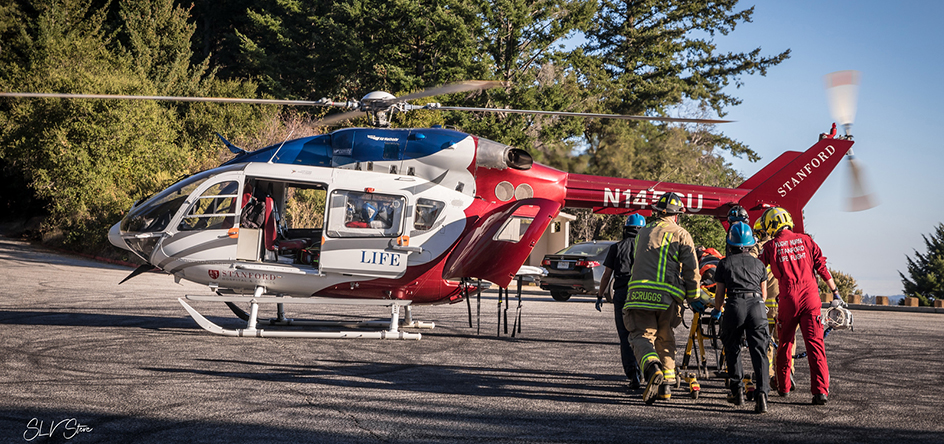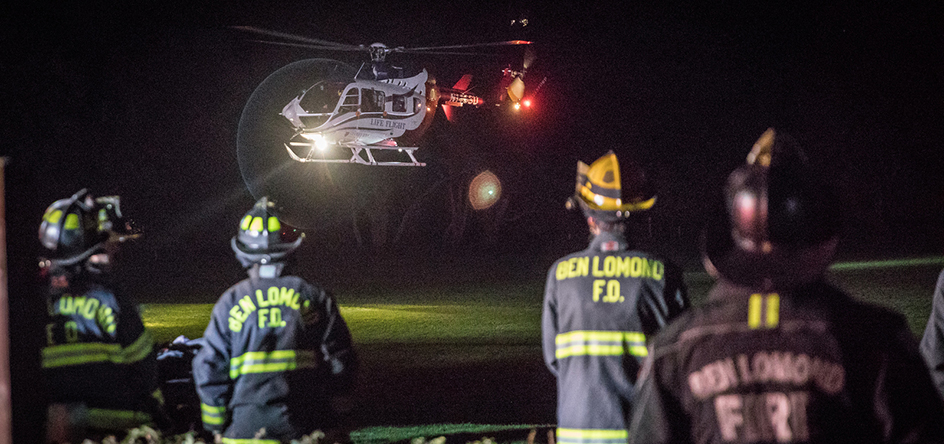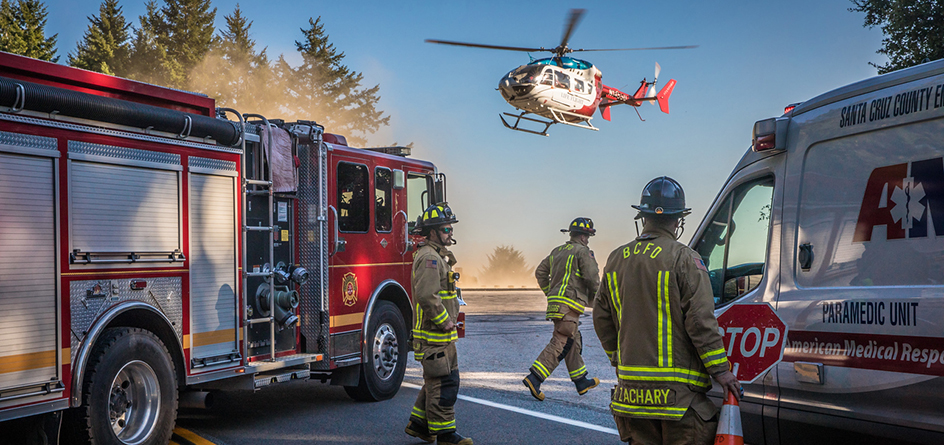Request Emergency Transport
For immediate assistance, call 1-800-321-7828. To view scene call requirements please click on the "Scene Call Resources" tab below.
- Our Services
- Our Services
- Our Team
- Scene Call Resources
- Fly-Along Program
- Our History
Stanford Medicine Life Flight started in May 1984 as the critical care air medical transport service of Stanford University Hospital in partnership with Stanford Medicine Children’s Health.
Interfacility Transfers
As a community resource, Life Flight is available to transport patients to any appropriate receiving hospital throughout California. All flights are staffed with a team of Life Flight registered nurses (RNs), experienced in critical care and emergency medicine, to care for patients during the flight.
911 Requests
We also provide advanced aeromedical evacuation support to any county emergency medical system. These calls can include motor vehicle crashes, bicycle accidents, falls, assaults, near-drownings, and other medical emergencies. Our aircraft can accommodate up to two patients. Approximately 20% of our flights are activated by a 911 call from the nine counties that make up the greater Bay Area.
Specialty Team Transports
Life Flight also provides aeromedical support to our partners at Stanford Medicine Children’s Health, transporting specialized teams from the Pediatric or Neonatal Intensive Care Units and Obstetric Department to outlying hospitals in order to bring patients back to the comprehensive services offered at this academic hospital.
Life Flight may, on occasion, use the Life Flight ambulance if the weather does not permit flying, if the referring facility cannot accommodate an aircraft, or in other situations. Care is still provided by the Life Flight RNs.
Capabilities and Equipment
- CMAC Video Laryngoscope
- Hamilton T1 Ventilator
- 2 Units Packed Red Blood Cells and 1 Unit Plasma on Every Flight
- Butterfly Point-of-Care Ultrasound
- Arterial Line Placement
- Rapid Sequence Intubation
- Surgical Airways
- Extracorporeal Membrane Oxygenation (ECMO), Impella, Intra-Aortic Balloon Pump (IABP)
Partner With Us
Interested in contracting with us or learning more about our services?
Phone: 650-723-5578
Fax: 650-723-6505
Service Area
Our service area extends from the Oregon/California border in the north to Reno, Nevada in the east, and as far south as Santa Barbara and everywhere in between. We will transport patients to any appropriate facility in our service area.
Stanford Life Flight's Aviation Partner and Part 135 Certificate Holder
Life Flight is accredited by the Commission on Accreditation of Medical Transport Systems (CAMTS).
Our flight crews meet rigorous standards. Our Stanford Medicine Life Flight nurses have extensive training and experience in caring for critically ill or injured patients in the airborne environment. Using an evidence-based set of hospital-developed protocols, they provide care consistent with that of Stanford Medicine, thereby becoming an extension of the Stanford Hospital. There are a number of procedures performed by our flight nurses that are beyond the regular scope of practice for registered nurses. Recurrent training and constant clinical review ensure continued competency in these skills. The pilots come to the program with several thousand hours of turbine helicopter experience and further training including annual recurrency check rides to maintain their instrument flight rules (IFR) pilot ratings.
Stanford Medicine Life Flight Nurses
Our Life Flight nurses are skilled in caring for and transporting the most critically ill and injured patients. Life Flight nurses function with a high level of autonomy and clinical nursing expertise, transporting high acuity populations such as patients on intra-aortic balloon pumps and extracorporeal membrane oxygenation (ECMO). Their expanded scope of practice includes rapid sequence intubation, surgical cricothyrotomy, escharotomy, arterial line insertion, femoral line placement, and finger thoracostomy, amongst others.
Our nurses train regularly under the supervision of our two medical directors to maintain expertise in all areas of intensive care and emergency nursing to maintain competency in these advanced skills:
- Life Flight nurses regularly rotate through the adult, pediatric, and neonatal intensive care units (ICUs), as well as through the emergency department (ED) and labor and delivery (L&D).
- Life Flight nurses must also attend two high fidelity patient simulation labs per year to maintain proficiency in their advanced procedure and performance skills.
- Each quarter, nurses can spend hours in the operating room (OR), working under the guidance of anesthesiologists to maintain proficiency in their airway skills.
- Life Flight nurses have the opportunity to attend a specialized cadaver lab annually.
The Crew
Our four pilots come to Life Flight with a wide variety of experiences in the civilian world and the military. All have well in excess of the 3,000 hours required at Stanford Medicine. Our pilots are contracted employees of Air Methods Corporation, our aviation partner. The capability of operating our EC 145 using instrument flight rules (IFR) has proved to be a valuable asset in operating near the Pacific Ocean with its frequent marine layer and foggy conditions. Each pilot undergoes check rides with an evaluator every six months to ensure the required proficiencies.
Life Flight's two aviation maintenance technicans are highly experienced and dedicated to ensuring the daily maintenance and upkeep of our Airbus EC 145 helicopter.
Stanford Life Flight Landing Zone ("LZ") Requirements
100 feet x 100 feet
- Wet down dusty areas prone to "brown out" conditions.
- No overhead OR approach obstructions
- Flat firm surface with no more than 5 degree slope
- 100 ft. from emergency vehicles, patient, or buildings
- 200 ft. from nonemergency personnel (on-lookers etc.)
- 500 ft. from horses and other domestic livestock, where possible
- Never downwind from hazmat area; always upwind
- 1,000 ft. from hazmat area
- Cement, asphalt, grass, or hard-packed dirt are preferred surfaces.
- No smoking is permitted near the LZ.
- No loose debris or loosely packed surfaces.
- Avoid use of traffic cones, flares, or yellow caution tape.
- Notify crew of any patients who are combative, in police custody, or contaminated by any hazmat, including gasoline.
- Although we can land without radio contact with the LZ commander during daylight hours, it's far safer if we have communication with the LZ commander. The California On-Scene Emergency Coordination (CALCORD) system provides the frequency of choice for most EMS helicopters.
Night Considerations
- Be more descriptive of the LZ and hazards; search carefully for overhead wires especially.
- Mark LZ clearly with strobes in a square pattern, bean bag lights, or vehicle lights crisscrossed at the landing spot. Emergency vehicles may also be parked on all four sides of the LZ perimeter. Parking emergency vehicles under overhead obstructions (wires, etc.) also helps pinpoint the locations of these to the flight crew.
- Never point lights toward the aircraft cockpit.
- Turn off headlights that point at the LZ or the aircraft after landing.
- Radio communications with the ground are a requirement for landing. As with daytime landings, CALCORD works well: 156.075.
Landing the Helicopter
- You may stand with your back to the wind with arms raised in the LZ to mark the intended spot of landing, but everyone must remain well clear of the LZ once the aircraft has begun its final approach. Ensure that anyone in the vicinity of the landing helicopter has turned away or is wearing protective goggles, that hats/helmets are tied on securely, and that hearing protection is utilized.
- Life Flight will contact the LZ officer usually when they are 5-10 minutes out from the LZ on CALCORD.
- When the LZ commander hears and has a visual reference of the Life Flight helicopter, he/she may proceed at that time with an LZ brief.
- A high and then low reconnaissance orbit is made to enable the Life Flight crew to view the entire LZ carefully, and once this is complete, they will advise that they are on final approach. The helicopter will typically land in the LZ with its nose into the wind and preferably facing the scene/ambulance.
- Approach a helicopter that is on/below a slope from the downslope position.
- Should you see anything that poses a danger or safety hazard or an overhead obstruction that you have missed, announce on the radio “Life Flight ABORT” or “ Life Flight STOP.”
- Never approach the helicopter while the blades are still turning. Always wait for the Life Flight crew members to come out to where you are. When taking the patient back to the helicopter, a Life Flight crew member will accompany you into the rotor disc zone and then accompany you out again.
- The Life Flight nurses will assess the patient briefly before moving them to the helicopter. Please keep the patient in the ambulance on monitors until the flight crew reaches you.
Gain Experience With Our Fly-Along Program (FLAP)
We offer professionals in pre-hospital emergency services and other clinicians who are likely to interface with the Life Flight Program the opportunity to fly with us to learn more about our safety procedures and operations.
Qualified Professionals
- Paramedics
- 911 dispatchers
- RNs
- MDs
- Firefighters
- All professionals must be currently licensed/certified.
Eligibility
- Must be 18 years old or older
- Must be fit, agile, and in good health
- Must adhere to dress requirements; helmets and flight suits provided
- Applicants must weigh 250 pounds or less and have a waist size of 44 inches or less to be properly secured in the seat belts.
What to Bring
- Personal identification (driver's license, Stanford Health Care/Lucile Packard Children's Hospital Stanford ID badge)
- Clothes to wear under your flight suit (all cotton preferable)
- Sturdy boots or active shoes (absolutely no clogs, sandals, or dress shoes)
- Cellphone
- Money for breakfast and lunch or snacks
Prior to Your Fly-Along
- Participants can only observe and are required to keep all patient information confidential. You will sign a confidentiality statement and Stanford Health Care code of conduct agreement on the day of your fly-along.
- Copies of applicable vaccinations and titers may be required from you as part of the application process.
- Watch the PowerPoint training module which will be emailed to you and be prepared for a quiz on its main points.
- Know you may not be able to accompany all transports (dependent on the weight and balance of the aircraft). The Life Flight crew will inform you during each transport request.
Interested in Flying With Us?
Email StanfordFLAP@stanfordmed.org for more information.
Stanford Life Flight commenced operations on May 1, 1984 with an Alouette III, the most popular EMS helicopter at that time, and one that functions well at high altitudes.
Let's have a look at the various helicopters we've operated over the years.
Alouette III
Alouette III, N607RM, operated by Rocky Mountain Helicopters, was Life Flight’s first helicopter. It was an interim helicopter from May 1984 through August 1984. It could carry two patients and had a ceiling of 21,300 ft.
Twin Star
Twin Star N57898 was our first permanent helicopter and was in operation between August 1984 and September 1986.
BK117
After the Twin Star came the aircraft that was to be Life Flight's main airframe in use at Stanford through the coming years, the BK117. The BK117 proved to be the most versatile for the job—a large separate cabin from the cockpit; a short, wide body profile; high main and tail rotor blades; the easy loading of the patient through aircraft rear; clamshell doors; IFR (instrument flight rules) capabilities in later models; and good patient access for the medical team.
EC145
As of July 2007, Stanford Life Flight has been operating in an Airbus EC145 helicopter. The same paint scheme which has become a highly recognized hallmark of our program has been maintained.
The EC145 is a twin-engine aircraft with superior lifting capabilities and is fully IFR equipped for single pilot operation. It has a large, spacious cabin that enhances clinical care, allowing for the transport of up to two patients.
Contact Information
Location:
Stanford Hospital
300 Pasteur Drive
Stanford, CA 94305
Mailing Address:
300 Pasteur Drive, HG-021
Stanford, CA 94305-5246
Phone:
650-723-5578
Business Hours:
24 hours a day | 7 days a week
Stanford Medicine Life Flight Leadership
Michael Baulch, RN, JD, CMTE
Program Manager
650-497-8674
MBaulch@stanfordhealthcare.org
Lee McMurray, MSN, BSN
Assistant Program Manager
650-721-5956
lmcmurray@stanfordhealthcare.org
Alfredo Urdaneta
Life Flight Medical Director
alfredou@stanford.edu
Melissa Vogelsong
Life Flight Associate Medical Director
mvoge@stanford.edu
Rudy Arthofer, MHA, BSN, RN
Associate Chief Nursing Officer
Inpatient Access, Capacity, Throughput & Efficiency
rarthofer@stanfordhealthcare.org



